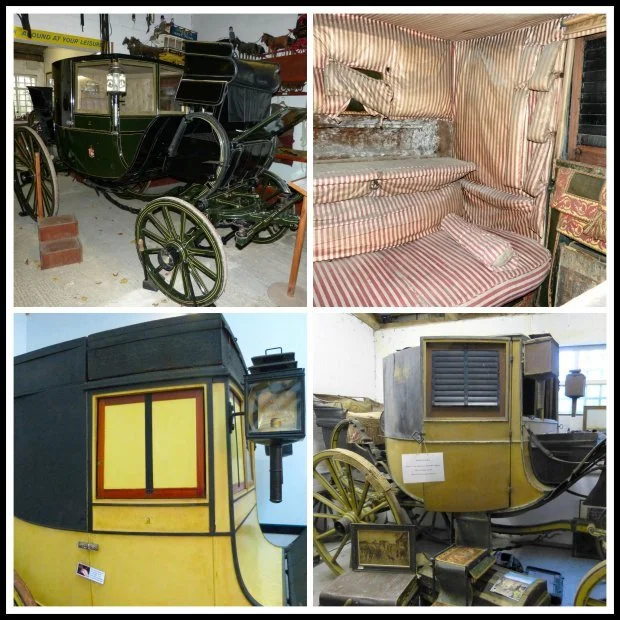Travelling chariots
Travelling chariots
One of the subjects I had to research for A Perfect Match was travel. Right at the start of my book, I needed to move Mrs Westlake and her daughter from Oxfordshire to London. Obviously they would travel by horse-drawn vehicle, but what type of carriage would they have used and how would this have been accomplished?
To help me with my research, I visited the National Trust Carriage Museum at Arlington Court in Devon and the Red House Stables in the Peak District in Derbyshire. I soon decided that the wealthy Mrs Westlake would undoubtedly have travelled by private chaise or travelling chariot:
She [Mrs Westlake] was very proud of her brand new travelling chariot which had been built to the latest design and offered the most comfortable ride that money could buy. 1
What was a travelling chariot?
A travelling chariot was a privately owned post-chaise used for long journeys.
Travelling chariot, National Trust Carriage Museum, Arlington Court (2014)
Why was it called a chariot rather than a coach?
It was called a chariot because it was designed to transport two people on a single, forward-facing internal seat, set behind the doors. A coach, on the other hand, was designed to transport four people on two internal seats—a forward-facing seat behind the doors like in a chariot, but with a backward-facing seat opposite, set ahead of the doors.
View inside a travelling chariot from the front window, Red House Stables (2014)
How was it driven?
A travelling chariot was designed to be driven by postilions or post-boys. This meant that the carriage was directed by one or more postilions—men riding the horses pulling the carriage—rather than by a coachman sitting on a coach box which would obscure the travellers’ view. The postilions usually rode the horses on the left or near side. The pair of horses nearest the carriage was called the wheelers and the pair in front was called the leaders.
Step up into a travelling chariot extended at Red House Stables (2014)
How did the post system work?
The post system enabled people to travel more quickly by refreshing their horses at different stages along the way. A traveller could hire horses and post-boys at a posting house to convey their carriage to a posting house further along the post road. This journey was known as a stage and was usually eight to ten miles long. At the end of the stage, the traveller paid off the post-boys who then stayed with the horses until they were hired by someone travelling in the opposite direction, back to the inn where they were hired.
An ostler at the second posting inn would harness a fresh team of horses to the carriage accompanied by a new set of post-boys, which would take the traveller on the second stage of their journey.
It was possible to hire a carriage as well as horses and these public travelling chariots were called post-chaises and were often painted yellow.
Travelling chariot, Red House Stables (2014)
Travelling with your own horses
Travellers frequently covered the first stage of their journey with their own horses and postilions. These postilions would ensure that the owner’s horses were returned to their stables or wait with them for the owner’s return journey.
The very wealthy sometimes travelled with their own horses along the whole length of the journey by having horses stabled at every stage along the route.
Travelling chariot with box seat fitted for town travel, Red House Stables (2014)
Adapted for travelling
Because a travelling chariot only had one seat and a window in front, it was ideal for sightseeing en route.
It sometimes had a dormouse boot—a system of folding panels inside the coach that allowed the passengers to stretch out their legs fully into the boot of the carriage.
Travellers could stow their belongings in the chariot’s imperials—light wooden cases covered with leather which could be carried on the roof and in the front boot.
In addition, the chariot might have a sword case which could only be accessed from the inside.
Travelling chariot with imperials mounted on the roof, National Trust Carriage Museum, Arlington Court (2014)
A versatile vehicle
A travelling chariot was not just used for travelling long distances. After arriving in town, the chariot could have a box seat added so that it could be driven around town by a coachman.
Behind the main body of the carriage, above the boot, was an outside seat called a rumble seat which could be used for transporting servants. This could be removed so that footmen could stand on the footboard behind the carriage when it was used around town.
Rumble seat on a travelling chariot, Red House Stables (2014)
Windows
The windows could be covered over with screens or shutters in order to shut out the light and allow the passengers to sleep and maintain their privacy. The different screens could be lowered and raised as required.
Inside a travelling chariot, showing the window screens, Red House Stables (2014)
Rachel Knowles writes faith-based Regency romance and historical non-fiction. She has been sharing her research on this blog since 2011. Rachel lives in the beautiful Georgian seaside town of Weymouth, Dorset, on the south coast of England, with her husband, Andrew, who co-writes this blog.
If you have enjoyed this blog and want to encourage us and help us to keep making our research freely available, please buy us a virtual cup of coffee by clicking the button below.
Note
Excerpt from A Perfect Match by Rachel Knowles.
Sources used include:
Badcock, Marigold, Gibbons, David and Parker-Williams, Demelza, Arlington Court and the National Trust Carriage Museum, National Trust Guide (2009)
National Trust carriage listing
Photos © Regency History









